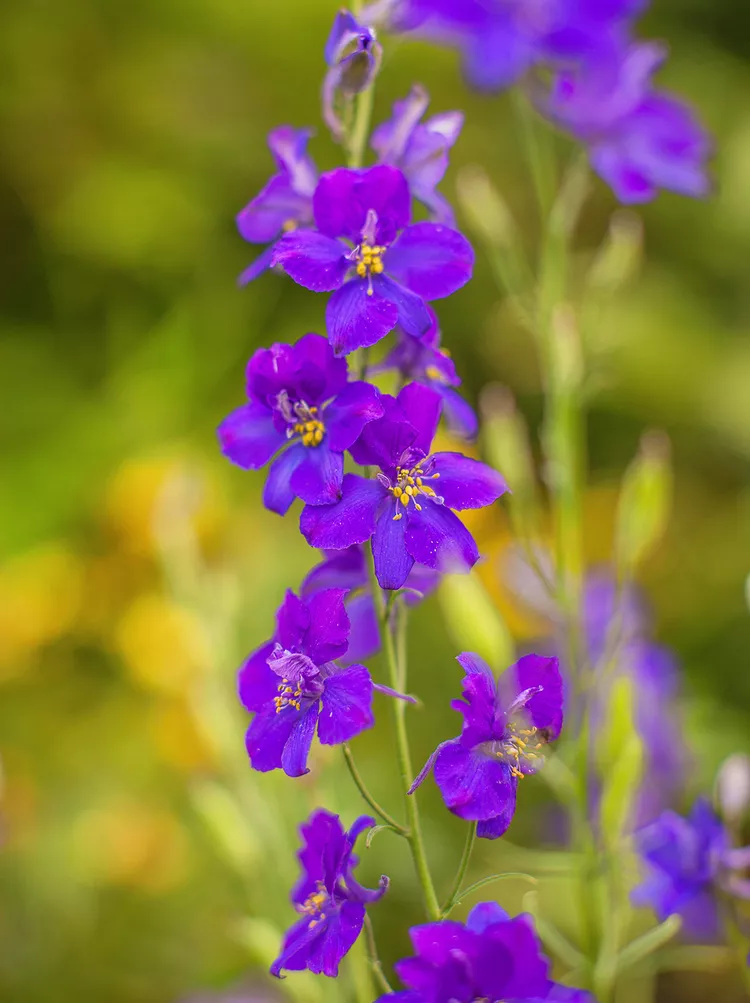There's something incredibly attention-grabbing about purple flowers. Historically, purple has been associated with royalty, nobility, ambition, and wealth. In the garden, flowers ranging from deep shades of violet to pale lavender can lend a mystical, moody, and charming element. Bring this evocative color to your garden by growing the following annual and perennial plants with purple flowers.
Allium
Alliums, also called ornamental onions, have sturdy stems and large, round heads comprised of tiny purple blooms in spring. There are hundreds of allium varieties to choose from, each with its own colorful flare. In addition to purple, they also come in pink, yellow, white, and green.
Growing Conditions: full sun and slightly acidic, well-drained soil
Height: 2 to 5 feet tall
Zones: 4-10
Catmint
Wands of small purple flowers appear on this aromatic perennial in early summer and continue for weeks. The blooms attract lots of pollinators, and pests usually leave them alone. Once the flowers fade, catmint (Nepeta spp.) will often produce a second flush of flowers if you cut them back by half.
Growing Conditions: Full sun and moist, well-drained soil
Height: 1-3 feet tall
Zones: 3-9
Clematis
Several types of clematis vines have purple flowers, such as Clematis 'Jackmanii' shown here. Another especially pretty option is the two-toned 'Sweet Summer Love', which has violet and purple petals and a pleasant fragrance. Use clematis to adorn trellises, fences, and garden gates.
Growing Conditions: full sun to part shade and fertile, well-drained soil
Height: 10 to 15 feet
Zones: 4-9
Creeping Phlox
This spring-blooming perennial plant boasts sweet smelling, star-shaped flowers that come in shades of purple, plus pink and white. A good purple-flowered variety to look for is 'Purple Beauty'. Plant creeping phlox (Phlox subulata) near garden walls, rocks, or along a slope so it can slowly spread into the landscape.
Growing Conditions: full sun and gritty, well-drained, alkaline soil
Height: 6 to 8 inches tall
Zones: 4-8
Delphinium
Delphiniums are cool-season perennials that come back year after year if properly cared for throughout the seasons. To encourage repeat bloom, regularly deadhead the faded flowers throughout the spring and summer. Numerous species and hybrids come in shades of purple, blue, pink, red, and white.
Growing Conditions: full to part sun and well-drained soil
Height: 4 to 5 feet tall
Zones: 3-7
All parts of delphiniums are very toxic to humans and animals.
Irises
In this large and diverse group of plants, many types of irises (Iris spp.) boast purple flowers. You can find tall or short irises, and some bloom in spring and others in summer. If you choose the right mix of varieties, you could have purple flowers blooming from your irises for months in your garden. Plant them in groups for an especially eye-catching display.
Growing Conditions: Full sun and moist, well-drained soil
Height: 6 inches to 4 feet tall (depending on variety)
Zones: 3-11
Larkspur
Tall and vibrant, larkspur (Consolida ajacis) is a purple-flowered, cool-season plant that blooms in spring and summer. Their vertical stalks look especially lovely in tall floral arrangements. The flowers also come in shades of pink, blue, and white.
Growing Conditions: full sun to part shade and well-drained, medium moisture soil
Height: 3 to 4 feet tall
Zones: annual
The leaves, flowers, and seeds of larkspur, an annual relative of delphinium, are toxic to people and animals.
Lavender
With the name lavender, it's no surprise these perennials are known for their beautiful purple flowers. Of course, their pleasant scent is another great reason to love lavender plants (Lavandula spp.). There are several different types of lavender to choose from, but most are easy to grow, drought tolerant, and resistant to pests.
Growing Conditions: full sun and average, well-drained soil
Height: 1-3 feet
Zones: 5-9 (depending on species)
Morning Glory
Fast-growing morning glory vines (Ipomoea purpurea) can take over garden trellises, fences, and gates, smothering them in pretty purple flowers throughout summer and fall. They also come in vibrant hues of pink, blue, and white.
Growing Conditions: full sun and well-drained soil
Height: 3 to 8 feet
Zones: annual
Pansies and Violas
These little gems are grown as short, colorful annuals that thrive in cooler temperatures and bloom from spring until the heat of summer causes them to die off. Pansies and violas (Viola spp.) also come in several shades of purple, as well as blue, red, pink, yellow, orange, and white.
Growing Conditions: full sun to part shade and moist, rich, well-drained soil
Height: 6 to 12 inches
Zones: 6-10
Salvias
Salvias (Salvia spp.) are another huge and diverse group of plants, with many different types offering pretty purple flowers that attract pollinators. For example, 'May Night' (shown here) is a favorite variety of meadow sage (Salvia sylvestris). Some types of salvias are hardier than others; some types like mealycup sage (Salvia farinacea) are usually grown as annuals in colder climates.
Growing Conditions: full sun and average, well-drained soil
Height: 1-3 feet tall
Zones: 3-10 (depending on species)
Our Favorite Gardening Tools and Supplies
The most used garden tools need to be of the highest quality. Our picks for garden hoses and nozzles will keep your plants sufficiently and adequately watered, whether they need it daily or hardly ever. Use a watering wand to cover larger areas and a watering can for more tight spots. A tough trowel helps with planting, as do sturdy garden gloves. If potted plants are your gardening goals, a potting bench and the right planters will make all the difference. All of our favorite gardening tools will make gardening chores easier and more enjoyable.




















